Trading strategies
Explore practical techniques to help you plan, analyse and improve your trades.
Our library of trading strategy articles is designed to help you strengthen your market approach. Discover how different strategies can be applied across asset classes, and how to adapt to changing market conditions.

.jpg)
Every trader has had that moment where a seemingly perfect trade goes astray.
You see a clean chart on the screen, showing a textbook candle pattern; it seems as though the market planets have aligned, and so you enthusiastically jump into your trade.
But before you even have time to indulge in a little self-praise at a job well done, the market does the opposite of what you expected, and your stop loss is triggered.
This common scenario, which we have all unfortunately experienced, raises the question: What separates these “almost” trades from the truly higher-probability setups?
The State of Alignment
A high-probability setup isn’t necessarily a single signal or chart pattern. It is the coming together of several factors in a way that can potentially increase the likelihood of a successful trade.
When combined, six interconnected layers can come together to form the full “anatomy” of a higher-probability trading setup:
- Context
- Structure
- Confluence
- Timing
- Management
- Psychology
When more of these factors are in place, the greater the (potential) probability your trade will behave as expected.
Market Context
When we explore market context, we are looking at the underlying background conditions that may help some trading ideas thrive, and contribute to others failing.
Regime Awareness
Every trading strategy you choose to create has a natural set of market circumstances that could be an optimum trading environment for that particular trading approach.
For example:
- Trending regimes may favour momentum or breakout setups.
- Ranging regimes may suit mean-reversion or bounce systems.
- High-volatility regimes create opportunity but demand wider stops and quicker management.
Investing time considering the underlying market regime may help avoid the temptation to force a trending system into a sideways market.
Simply looking at the slope of a 50-period moving average or the width of a Bollinger Band can suggest what type of market is currently in play.
Sentiment Alignment
If risk sentiment shifts towards a specific (or a group) of related assets, the technical picture is more likely to change to match that.
For example, if the USD index is broadly strengthening as an underlying move, then looking for long trades in EURUSD setups may end up fighting headwinds.
Setting yourself some simple rules can help, as trading against a potential tidal wave of opposite price change in a related asset is not usually a strong foundation on which to base a trading decision.
Key Reference Zones
Context also means the location of the current price relative to levels or previous landmarks.
Some examples include:
- Weekly highs/lows
- Prior session ranges, e.g. the Asian high and low as we move into the European session
- Major “round” psychological numbers (e.g., 1.10, 1000)
A long trading setup into these areas of market importance may result in an overhead resistance, or a short trade into a potential area of support may reduce the probability of a continuation of that price move before the trade even starts.
Market Structure
Structure is the visual rhythm of price that you may see on the chart. It involves the sequences of trader impulses and corrections that end up defining the overall direction and the likelihood of continuation:
- Uptrend: Higher highs (HH) and higher lows (HL)
- Downtrend: Lower highs (LH) and lower lows (LL)
- Transition: Break in structure often followed by a retest of previous levels.
A pullback in an uptrend followed by renewed buying pressure over a previous price swing high point may well constitute a higher-probability buy than a random candle pattern in the middle of nowhere.
Compression and Expansion
Markets move through cycles of energy build-up and release. It is a reflection of the repositioning of asset holdings, subtle institutional accumulation, or a response to new information, and may all result in different, albeit temporary, broad price scenarios.
- Compression: Evidenced by a tightening range, declining ATR, smaller candles, and so suggesting a period of indecision or exhaustion of a previous price move,
- Expansion: Evidenced by a sudden breakout, larger candle bodies, and a volume spike, is suggestive of a move that is now underway.
A breakout that clears a liquidity zone often runs further, as ‘trapped’ traders may further fuel the move as they scramble to reposition.
A setup aligned with such liquidity flows may carry a higher probability than one trading directly into it.
Confluence
Confluence is the art of layering independent evidence to create a whole story. Think of it as a type of “market forensics” — each piece of confirmation evidence may offer a “better hand’ or further positive alignment for your idea.
There are three noteworthy types of confluence:
- Technical Confluence – Multiple technical tools agree with your trading idea:
- Moving average alignment (e.g., 20 EMA above 50 EMA) for a long trade
- A Fibonacci retracement level is lining up with a previously identified support level.
- Momentum is increasing on indicators such as the MACD.
- Multi-Timeframe Confluence – Where a lower timeframe setup is consistent with a higher timeframe trend. If you have alignment of breakout evidence across multiple timeframes, any move will often be strengthened by different traders trading on different timeframes, all jumping into new trades together.
3. Volume Confluence – Any directional move, if supported by increasing volume, suggests higher levels of market participation. Whereas falling volume may be indicative of a lesser market enthusiasm for a particular price move.
Confluence is not about clutter on your chart. Adding indicators, e.g., three oscillators showing the same thing, may make your chart look like a work of art, but it offers little to your trading decision-making and may dilute action clarity.
Think of it this way: Confluence comes from having different dimensions of evidence and seeing them align. Price, time, momentum, and participation (which is evidenced by volume) can all contribute.
Timing & Execution
An alignment in context and structure can still fail to produce a desired outcome if your timing is not as it should be. Execution is where higher probability traders may separate themselves from hopeful ones.
Entry Timing
- Confirmation: Wait for the candle to close beyond the structure or level. Avoid the temptation to try to jump in early on a premature breakout wick before the candle is mature.
- Retests: If the price has retested and respected a breakout level, it may filter out some false breaks that we will often see.
- Then act: Be patient for the setup to complete. Talking yourself out of a trade for the sake of just one more candle” confirmation may, over time, erode potential as you are repeatedly late into trades.
Session & Liquidity Windows
Markets breathe differently throughout the day as one session rolls into another. Each session's characteristics may suit different strategies.
For example:
- London Open: Often has a volatility surge; Range breaks may work well.
- New York Overlap: Often, we will see some continuation or reversal of morning trends.
- Asian Session: A quieter session where mean-reversion or range trading approaches may do well
Trade Management
Managing the position well after entry can turn probability into realised profit, or if mismanaged, can result in losses compounding or giving back unrealised profit to the market.
Pre-defined Invalidation
Asking yourself before entry: “What would the market have to do to prove me wrong?” could be an approach worth trying.
This facilitates stops to be placed logically rather than emotionally. If a trade idea moves against your original thinking, based on a change to a state of unalignment, then considering exit would seem logical.
Scaling & Partial Exits
High-probability trade entries will still benefit from dynamic exit approaches that may involve partial position closes and adaptive trailing of your initial stop.
Trader Psychology
One of the most important and overlooked components of a higher-probability setup is you.
It is you who makes the choices to adopt these practices, and you who must battle the common trading “demons” of fear, impatience, and distorted expectation.
Let's be real, higher-probability trades are less common than many may lead you to believe.
Many traders destroy their potential to develop any trading edge by taking frequent low-probability setups out of a desire to be “in the market.”
It can take strength to be inactive for periods of time and exercise that patience for every box to be ticked in your plan before acting.
Measure “You” performance
Each trade you take becomes data and can provide invaluable feedback. You can only make a judgment of a planned strategy if you have followed it to the letter.
Discipline in execution can be your greatest ally or enemy in determining whether you ultimately achieve positive trading outcomes.
Bringing It All Together – The Setup Blueprint
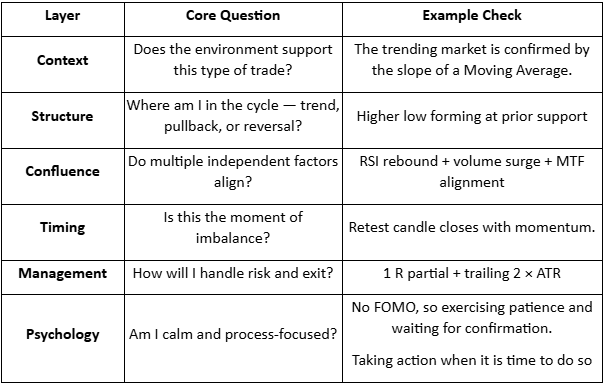
Final Thoughts
Higher-probability setups are not found but are constructed methodically.
A trader who understands the “higher-probability anatomy” is less likely to chase trades or feel the need to always be in the market. They will see merit in ticking all the right boxes and then taking decisive action when it is time to do so.
It is now up to you to review what you have in place now, identify gaps that may exist, and commit to taking action!


A market bubble occurs when asset prices rise far beyond any reasonable valuation.
It is driven by speculation, emotion, and the belief that prices will continue rising indefinitely.
For traders, the challenge is more about finding a way to manage a bubble, rather than just identifying that one exists.
By their very nature, bubbles can persist far longer than any logical analysis suggests. There are opportunities as they develop, but timing their peak is virtually impossible.
Understanding their characteristics and having a systematic way of managing bubbles in your trading strategy is worth considering for any trader.
What is a Bubble?
Market bubbles have distinct features that separate them from normal bull markets or even overvalued conditions for a particular asset:
Dramatic Price Appreciation Disconnected From Fundamentals
In a bubble, traditional valuation metrics become meaningless.
Company or asset fundamentals that usually matter to market participants are ignored in the hope of what might be.
Cash flow, profit margins, competitive positioning, and (in some cases) producing revenue may be dismissed.
Widespread Participation And "This Time Is Different" Narratives
Bubbles require mass market participation.
When every headline you see or article you read references "this time is different," or "the old rules don't apply anymore," it is a sign that the collective psychology has shifted from normal caution.
Social media may begin to explode with ever more frequent success stories, and for the individual trader, the fear of missing out becomes increasingly overwhelming.
Credit and Leverage Fuelling Demand
Bubbles are typically accompanied by easier credit conditions.
When interest rates are lowered and investors are confident in general economic conditions, any spare cash is put to work.
In stock or other market bubbles, you may see retail traders maxing out credit cards to buy call options, with the put/call ratio becoming increasingly distorted.
This leverage often amplifies the rise and the eventual fall, making the risk even more acute and potentially damaging to trader capital.
Vertical Price Charts in Final Stages
One of the telltale signs of a bubble's final phase is a parabolic price chart.
Prices seem to go up daily, and every minor pullback is short-lived (creating more buying pressure).
This is the euphoria stage. It is where the greatest danger is.
The fear of missing out on further moves is at its highest, and a logical willingness to take profit off the table diminishes in the minds of ever more excited traders.
New participants may continue to enter solely for the way the price is appreciating. Entering into the move only understanding that what they are buying is going up, so they want to join in too.
Bubble vs. Overvalued: Key Differences
Not every expensive market is a bubble. Several characteristics distinguish a bubble from a simpler and far less dangerous overvaluation:
Elevated Valuations With Reasoned Fundamental Justification
An overvalued market has stretched valuations, but can point to real supporting factors (at least to some degree).
Examples include strong earnings growth, low interest rates, disruption in service or productivity, and providing genuine temporary value.
Even if prices respond to less obvious immediate influencing factors, such as international events, policy changes, and supply issues, the fact that some factors justify continued positive sentiment (even if somewhat unfulfilled) is a positive sign.
Linear or Steady Uptrend
Overvalued markets tend to grind higher with a more sustainable trend rather than a vertical spike. There are normal corrections along the way, even if the highs and lows of a fluctuation are higher.
Reasonable Participation Levels
There is evidence of institutional investors buying on any dips, but common retracements last days or even weeks.
Retail participation exists but isn't frenzied and plastered all over social media every day or referenced in mainstream media consistently.
Some Scepticism Still Exists
There will be some legitimate and contrary opinions about valuations. Major financial media will present both bearish and bullish cases when a stock is discussed.
Trading Strategies for Potential Bubble Management
Here is the scenario: You bought early in the up move, you are now in profit, but some of the bubble signs are beginning to show up in your thinking.
Tiered Profit-Taking Strategies
Don't try to pick the top. As an alternative approach, begin to scale out systematically with partial closes. This will alleviate the potential for FOMO creeping in.
You could stage this with set points, e.g. sell 30% when you've doubled, another 30% when you've tripled, 20% when conditions clearly show evidence of entering bubble territory and, having banked a substantial profit already, you keep the final 20% with a trailing stop for the final run if it happens.
Trailing Stops With Wider Bands to Accommodate Volatility
Let’s assume you see the merit in some form of trial stop. In bubble conditions, normal stop distances will get you whipsawed out. Use percentage-based trailing stops or ATR multiples with enough room to accommodate bigger intraday moves.
For example, if your norm is to trail your stop 1.5 x ATR behind price at the end of every candle, then in increasingly volatile conditions during a parabolic move, consider 2,5 x ATR to allow room to move while still offering protection against price collapse.
Reduce Position Sizing and Leverage
The temptation in bubbles is to maximise gains by increasing your margin and entering more and more positions in one asset.
High leverage and significant single asset exposure in bubble conditions is a potential death sentence to trading capital.
Recognising the added risks you are contemplating before entry is critical. Combining this with an approach that reduces position sizing and increases margin requirements is consistent with good trading practice as risk increases.
Planned and Rigid Exits
Before buying, you should have already made decisions on what exit approaches you should take and the parameters at which they will be executed,
Having the exit plan as you enter can limit the chance of getting trapped by greed. Neglecting this and focusing on the opportunity alone can be disastrous.
Never Assume You Can Time the Top
It is usually a big mistake if you believe you will recognise the exact top and exit perfectly. Let’s be frank, even if you hit it lucky once, you won't be able to every time — no one does.
Recognise Behavioural Biases That May Affect Your Judgment
Bubbles can create powerful psychological forces.
Anchoring bias may mean that you fixate on peak prices. Confirmation bias makes you seek information supporting your bullish view and ignore opposing evidence. Recency bias makes you believe the recent trend will continue indefinitely.
The indisputable key to any bias management is awareness and honesty that some markets may just not be for you (or if they are, to proceed with extreme and continuous caution).
Psychological Preparation for Rapid Reversals
Mentally rehearse the worst scenario and clarity of planned action, e.g., “if it drops 10% in three days, I will ….”.
Having thought through your response and armed with unambiguous exits in advance will make execution easier when emotions run high and begin to dominate.
Final Thoughts
Extreme valuations, little fundamental underpinning, parabolic price action, and universal bullishness should be part of your bubble identification checklist and flag that your bubble action plan should be implemented.
If you are already in, or tempted to be so, then approach bubbles with honesty, awareness of your trading self and extraordinary discipline to follow through, as predicting what and when things may dramatically turn is close to impossible.
Never forget you are not smarter than the market, but you can (potentially) be smarter than many traders by planning and doing the right thing.


The decision to scale (increase the traded lot size of a specific EA) should be based on statistical evidence that indicates your EA has the potential to perform to certain expectations.
Equal weight should be given to the decision to scale, as to the initial decision to deploy an EA. This guide provides an indicative approach on how to put together and action your scaling plan.
Before You Start Your Scaling Plan
Important: this should be an individual plan that is consistent with your personal trading objectives, your EA portfolio, and your personal financial situation (including account size).
We are going to use a starting lot of 0.10 per trade in the examples in this document —you want to adjust this based on your own risk tolerance.
Whatever your chosen lot size start point, EA scaling should be a pre-planned incremental approach, scaling stepwise based on performance metrics you are seeing in your live trading account.
You should also have assessed the current margin usage of your EA portfolio exposure to ensure that any scaling and related increased margin requirements are appropriate to the size of your account.
Suggested Scaling Baseline Requirements
Scaling should only be performed when your EA is performing to what you deem to be a good standard. To make this judgment, you need to set some minimum performance standards.
The past performance of your EA is not a guarantee of future performance. If market conditions change, you must remain vigilant and continue to measure performance on an ongoing basis for every live EA you have.
You need to define the key metrics that are important to you.
Two important metrics to include are:
- The number of trades: to provide some evidence of reliability
- The period of time: to have had exposure to at least some variation in market conditions
Example of how you may lay your metrics out in a table:

Some may choose to include proximity to original expectations of other metrics, such as minimum win rate, average profit in winning trades, and average loss in those that go against you.
It should only be after your metrics are met that lot scaling begins on any specific EA.
Lot Size Scaling Ladder
Below is an example of a performance-based scaling plan assuming a 0.10-lot baseline.
Again, this is indicative. It provides a framework with clear review dates and an approach that illustrates incremental scaling. You must still define a regime that is right for your specific trading objectives.
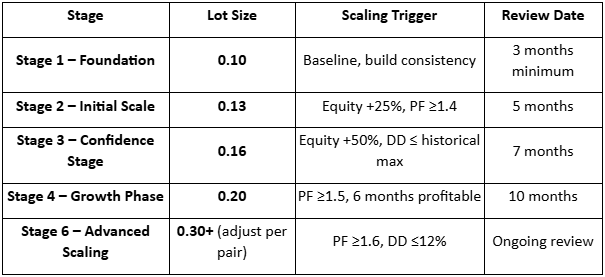
Risk Guardrails
It is vital to keep an eye on your general account risks and have limits in place that guide your EA use.
Such limits must be constant across all stages of scaling and referenced beyond the risk of a single EA, but to your portfolio as a whole.:
Per-Trade Risk (Nominal)
Trade risk for any one trade should be seen in the context of account size and the dollar risk based on the risk parameters you have set for your EA.
Specify a maximum percentage of the account balance — a $200 loss is more impactful on a $1000 account compared to a $10,000 account.
Stick to what is right for you in terms of your tolerable risk level based on your trading objectives and financial situation. A common suggestion is a 1-2% risk of account equity per trade.
Total Open Exposure
Specifying maximum exposure in the number of EAs open at any time and those that use the same asset class is important for overall portfolio risk management.
There are tools you can use to monitor exposure risk generally, as well as those that can be used to indicate single asset exposure.
Margin Usage
It is always desirable that your set exit approaches and parameter levels are what your exits are based on. It should not be because your margin usage has meant you have moved into a margin call situation.
Specify a minimum level to adhere to and make sure that your account is sufficiently funded. If volatility or slippage rises (e.g., news events or illiquid sessions), reduce lot size temporarily.
Scaling Psychology – Managing “Big Numbers”
As lot sizes rise, your emotions may respond accordingly when you see the larger dollar amounts that your EA is generating.
If you are used to seeing an average profit of $100 and average loss of $50, and suddenly you are seeing significantly bigger numbers, it creates an emotional challenge where you may be tempted to do a “discretionary override”.
Although there are situations, such as major market events, overexposure in a specific asset, or VPS or account system problems, where such intervention may be considered, generally this would distort the actual performance evaluation of your EA and is not encouraged (unless it is pre-planned).
The table below presents some of the generally accepted challenges and offers suggestions on how to manage them.
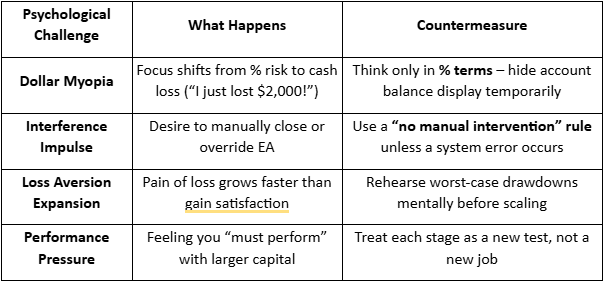
Your Plan Into Action…
In practical terms, your scaling plan should have two components:
- The key parameters for action on your chosen key metrics
- Specified periodic review times to make your next scaling decision
This is not a race. Having systems in place facilitates creating the opportunity that scaling brings while still mitigating the risks.


You've been using a 30-pip trailing stop for as long as you can remember. It feels professional, manageable and relatively safe.
But during volatile sessions, you see your winners get stopped out prematurely, while low-volatility winners drift back and hit stops that are relatively too tight.
Same 30 pips, different market contexts, but inconsistent in the protection of profit and overall results.
The Fixed-Pip Fallacy?
Traders gravitate toward fixed pip trailing stops because they feel concrete and calculable. The approach is easy to execute, readily automated through platforms like MetaTrader, and aligns with how most people naturally think about profit and loss.
But this simplicity masks a fundamental problem.
A twenty-five pip move in EURUSD during the London open represents an entirely different market event than the same move during the Asian session. The context matters, yet the fixed-pip approach treats them identically.
This becomes even more problematic when you consider different currency pairs. GBPJPY might have an average true range of thirty pips on an hourly chart, while EURGBP shows only ten. The same trailing stop applied to both instruments ignores the reality that volatility varies dramatically across pairs.
Timeframe introduces yet another layer of complexity. Take AUDUSD as an example: a ten-pip move on a four-hour chart barely registers as meaningful price action, but on a five-minute chart it represents a significant swing. The fixed-pip method treats these scenarios as equivalent.
The natural response might be to use something more sophisticated, like an ATR multiple. This accounts for your chosen timeframe, the instrument's normal volatility, and even session differences. But it brings its own complications.
When do you measure the ATR? Do you use the value at entry, knowing it might be distorted by sessional effects? Or do you make it dynamic, which becomes far more complex to implement in practice?
Perhaps there's another way forward that doesn't rely on abstract measures of volatility but instead responds directly to the movement of price in relation to the trade you're actually in—accounting for your lot size and the profit you've already captured.
Maximum Give Back: The Percentage Approach
Instead of asking "how do I protect profit after fifty pips," ask "how do I protect profit after giving back a certain percentage of open gains."
Consider a maximum give-back threshold of 40%. When your trade is up one hundred pips, the trailing stop activates if price retraces forty pips from peak, locking in a minimum of sixty pips.
But when that same trade reaches two hundred fifty pips of profit, the stop adjusts, and now it activates at a one-hundred-pip pullback, securing at least one hundred fifty pips. The stop distance scales naturally with the magnitude of the win you're sitting on.
This creates a logical asymmetry that fixed pip approaches miss entirely. Small winners receive tighter protection. Big winners get room to breathe.
The approach adapts automatically to what the market is actually giving you in real time, without requiring you to predict anything in advance.
You don't need to maintain a reference table where EURUSD gets thirty pips and GBPJPY gets sixty. You don't need different standards for different instruments at all.
The same 40% logic works whether the average true range is high or low, whether volatility is expanding or contracting. It is designed to be more adaptive to regime changes than fixed-pip stops, potentially requiring less manual recalibration as it's responding to the trade itself rather than to abstract measures of what the instrument normally does.
The market tells you how much it's willing to move in your direction, and you protect that information proportionally. Nothing more complicated than that.
Key Parameters to Specify in Your System:
- Maximum Give Back Percent: 30-50% is typical, but is dependent on how much profit retracement you can tolerate.
- Minimum Profit to Activate: In dollar amount or an ATR multiple form entry. This prevents premature exits on tiny winners, e.g., if it has moved 5 pips at 40% that would mean you are only locking in a 3-pip profit.
- Update Frequency: Potentially every bar. More frequent, but there may be issues if there is a limited ability to look at the market (if using some sort of automation, this could be programmed).
Is Maximum Giveback Always the Optimum Trail?
As with many approaches, results can be highly dependent on underlying market conditions. It is important to be balanced.
The table below summarises some observations when maximum giveback has been used as part of automated exits.
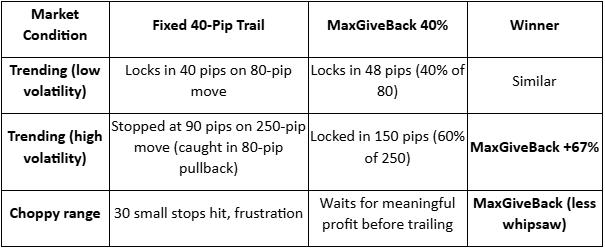
The major difference isn’t likely to be an increased win rate. It is about keeping more of your runners during high-volatility price moves rather than donating them back to the market.
It may not always be the best approach, as different strategies often merit different exit approaches.
There are two obvious scenarios where fixed pips may still be worth consideration.
- Very short-term scalping (sub-20 pip targets)
- News trading, where you want instant hard stops
Integrating Maximum Giveback With Your System
You may have other complementary exit filters in place that you already use. Remember, the ideal is often a combination of exits, with whichever is triggered first.
There is no reason why this approach will not work well with approaches such as set stops, take profits and partial closes (where you simply use maximum Giveback in the remainder as well as time-based exits.
Final Thoughts
To use fixed-pip trailing stops irrespective of instrument pricing, volatility, timeframe, and sessional considerations is the trading equivalent of wearing the same jacket in summer and winter.
Maximum Give Back trailing adjusts to the ‘market weather’. It won't make bad trades good, but it could help stop you from cutting your best trades short just because your stop was designed for average conditions.
The market doesn't trade in averages but has specific likely moves dependent on context. Your exits should not be average either.


You have just identified a breakout above $50 resistance that historically wins 65% of the time — with a degree of confidence, you decide to take the trade.
Minutes later, the market starts to stall. Volume fades, price begins to hesitate, and eventually, your stop loss is hit, leaving you to wonder why your “65% setup” didn’t work.
The root cause of what happened is not your setup, but rather the fact that you assume that the probability of a specific trade outcome stays constant after entry.
This assumption locks you into a “static probability trap.”
There is a tendency to treat probability as frozen in time after entering a trade, when in practice it shifts continuously throughout the life of a trade as new evidence enters the market.
Even if this new evidence may not be particularly dramatic, it can still have profound implications for the likelihood of a continuation of current sentiment and price action.
Unconditional Probability: Your Pre-trade State.
What you can rely on as part of your pre-entry decision-making is unconditional probability.
This is your measured historical performance of a setup under similar conditions. It is your expected win rate and previous evidence of hitting a take-profit level.
The pre-trade belief that “This pattern works 60% of the time” is a backward-looking statement, and although based on some evidence, it shapes your belief about how this type of setup behaves on average.
However, as soon as you enter, the truth is that you are no longer dealing with a statistical average, but with this specific trade, unfolding before your eyes in this market environment, right now.
Conditional Probability: After You Enter
Once in the trade, your question becomes “Given what’s happening now with current price movement, volume, time, and volatility, what’s the probability of success?”
This live review of your pre-trade expectation is the conditional probability — your new probability estimate conditioned on the actual market response that is unfolding.
Each new candle, volume shift, or volatility change is new information, irrespective of the underlying cause, and information changes probability.
You are looking to see if:
- Trading volume is confirming or rejecting your entry expectations.
- If “time in the trade” supports further price moves in your favour or decay in market enthusiasm, evidenced in a drop in momentum.
- There are volatility changes that may be indicative of market sentiment accelerating or rejecting the initial move.
This is all about you recognising that some of these changes may result in adverse price moves. Having timely interventions that aim to protect capital and not donate much of your profit back to the market.
Emotional Resistance to Conditional Probability Thinking
As with many trading situations, there is a psychological component of decision-making that can get in the way.
Emotional “demons” that may influence this may briefly include the following:
- Anchoring: “I have done my analysis — it should work.”
- Sunk-Cost Bias: “I’m already in, I might as well wait and see what happens next.”
- Ego: Some may view that exiting means admitting they were wrong.
- Lack of knowledge: “I don’t know how to update probabilities or take appropriate actions.”
- FOMO (fear of missing out): “What if I exit and then runs in my favour?”
These biases keep traders fixed at entry from mental, emotional, and statistical perspectives.
Updating Probability in Real Time
When you boil it all down into absolute core principles, three critical factors dominate the “in the trade” probability landscape after trade entry.
1. Trading Volume — Conviction or Rejection
Volume is the purest signal of conviction. It shows the strength behind the move and how much belief the market has in your trade direction.
- High volume in your direction = strong confirmation; probability rises.
- Fading or below-average volume = weak conviction; probability erodes.
- High volume against you = rejection; probability collapses.
You can think of volume as your real-time market feedback gauge. It is the purest real-time evidence, in combination with price, of what other traders are thinking.
When price and volume disagree, this is a signal that the odds may (or already have) changed.
2. Time Elapsed — Pattern Decay
Every trade setup has a shelf life. A breakout that has not moved after a few candles can become statistically weaker than one that fired almost immediately.
The potential scenarios are:
- Quick follow-through: expected behaviour; your entry probability is likely to be intact.
- Extended stagnation: increasing probability decay due to trades losing confidence in the trade direction
- Delayed reversal: final evidence of pattern failure.
Each candle that passes without confirmation can be viewed as a ‘vote’ against your trade from the market.
This dissuades further trading interest in your desired direction, as opposed to when a market is enthused and buying seems to create ever-increasing interest as those who are fearful of missing out jump on board.
3. Volatility Regime — The Environment Shift
Volatility defines your market environment, and this environment can change fast.
- Volatility expansion in your favour confirms momentum; the probability of desirable and expected outcomes increases.
- Volatility expansion against you suggests a potential structural shift in the market, resulting in a fast drop in probability.
- Volatility contraction suggests market consolidation or exhaustion. This may be seen as a flattening of price action and a move from strongly directional to a more neutral price move.
Volatility regime shifts are a potential market indication that “the game when you entered is no longer the same.”
Putting It All into Practice: Your End-of-Candle Review
Managing conditional probability doesn’t mean reacting to every tick. It is formalising a systemised reassessment at defined intervals, often doing an “End-of-Candle Review”, on your chosen trading timeframe as a start point.
At the close of each bar on your trading timeframe, you need to pause and ask the following key questions:
- Has price behaved as expected?
- Yes → maintain or increase confidence.
- No → reduce exposure or prepare to exit.
- Is volume confirming or fading?
- Rising with direction → edge intact.
- Falling or reversing → edge weakening.
- Is volatility expanding or contracting?
- Expanding in your favour → stay the course.
- Contracting or reversing → reassess.
- Has too much time passed without progress?
- Yes → probability decay in play; consider exiting or scaling out.
- What’s the appropriate action?
- Hold, reduce, tighten, or exit — but always act in alignment with the evidence.
This simple routine keeps your decision-making informed by data, adaptable to market change, and unemotional.
None of the above is particularly ‘rocket science,’ but as with most things in your trading, it will require some work at the front end.
Measure the “what if” scenario against previous trades and comparatively measure your old way versus your new system over time to allow for confirmation of this as an approach, but also to allow refinement based on evidence.
Final thoughts
The probability of a trading outcome in a single trade is never static. It evolves with every candle, every shift in volume, and every minute of market time as new information is released.
It does require a mindset shift. As traders, we need to move from the standard “It’s a 65% setup, so I’ll hold.” To an approach that adopts the approach of “It was a 65% setup on entry, but what is the market evidence suggesting now?”
You are reacting to evolving information, and effective probability management becomes something beyond having one good trade (or avoiding a bad one) that compounds small improvement over hundreds of trades into measurable performance.


Most traders understand EA portfolio balance through the lens of traditional risk management — controlling position sizes, diversifying currency pairs, or limiting exposure per trade.
But in automated trading, balance is about deliberately constructing a portfolio where different strategies complement each other, measuring their collective performance, and actively managing the mix based on those measurements.
The goal is to create a “book” of EAs that can help diversify performance over time, even when individual strategies hit rough patches.
A diversified mix of EAs across timeframes and assets can, in some cases, reduce reliance on any single strategy. This approach reduces dependency on any single EA’s performance, smooths your overall equity curve, and builds resilience across changing market conditions.
It’s about running the right mix, identifying gaps in your coverage, and viewing your automated trading operation as an integrated whole rather than a collection of independent systems.
Basic Evaluation Metrics – Your Start Point
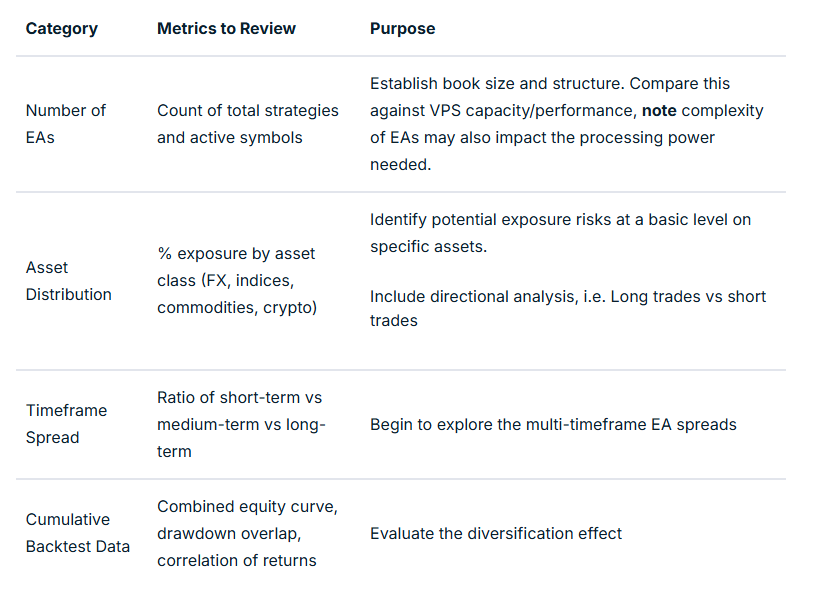
Temporal (timeframe) Balancing
When combined, a timeframe balance (even on the same model and instrument) can help flatten equity swings.
For example, a losing phase in a fast-acting M15 EA can often coincide with a profitable run in an H4 trend model.
Combining this with some market regime and sessional analysis can be beneficial.
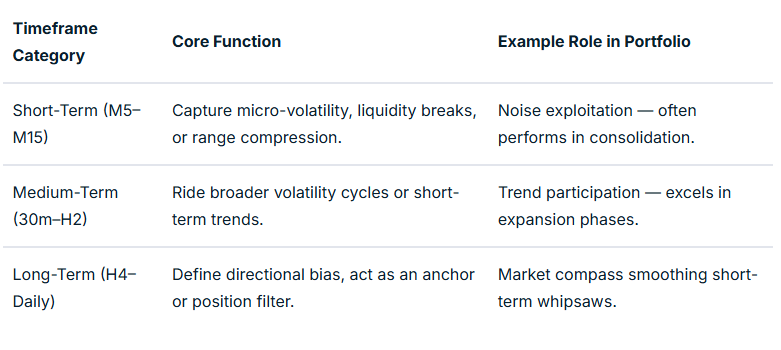
Asset Balance: Managing Systemic Correlation Risk
Running five different EAs on USDJPY might feel diversified if each uses different entry logic, even though they share the same systemic market driver.
But in an EA context, correlation measurement is not necessarily between prices, but between EA returns (equity changes) relating to specific strategies in specific market conditions.
Two EAs on the same symbol might use completely different logic and thus have near-zero correlation.
Conversely, two EAs on a different symbol may feel as though they should offer some balance, but if highly correlated in specific market conditions may not achieve your balancing aim.
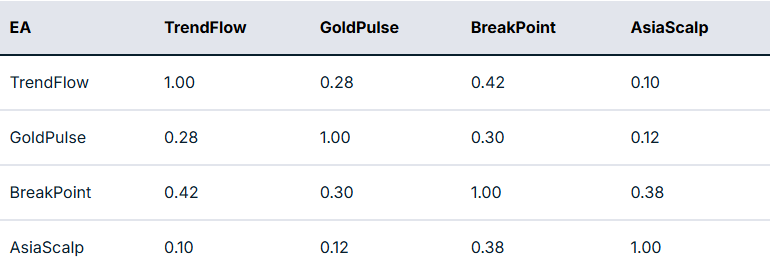
In practical terms, the next step is to take this measurement and map it to potential actionable interventions.
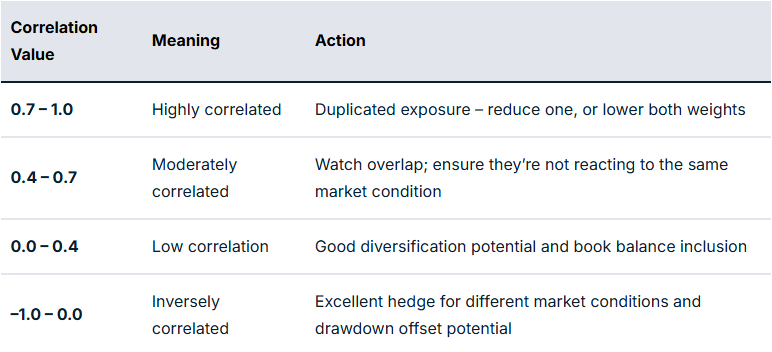
For example, if you have a EURUSD Trend EA and a GBPUSD Breakout EA with a correlation of 0.85, they are behaving like twins in performance related to specific market circumstances. And so you may want to limit exposure to some degree if you are finding that there are many relationships like this.
However, if your gold mean reversion EA correlates 0.25 compared to the rest of your book, this may offer some balance through reducing portfolio drawdown overlap.
Directional and Sentiment Balance
Markets are commonly described as risk-on or risk-off. This bias at any particular time is very likely to impact EA performance, dependent on how well balanced you are to deal with each scenario.
You may have heard the old market cliché of “up the staircase and down the elevator shaft” to describe how prices may move in alternative directions. It does appear that optimisation for each direction, rather than EAs that trade long and short, may offer better outcomes as two separate EAs rather than one catch-all.
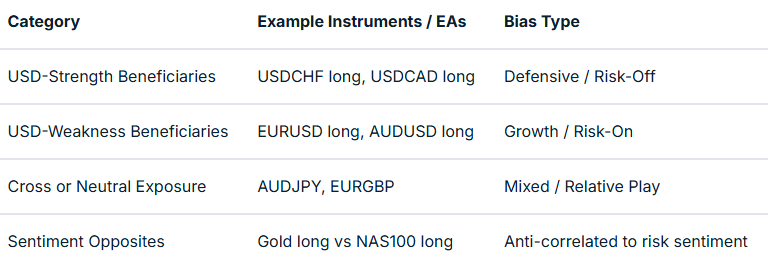
Market Regime and Volatility Balance
Trend and volatility states can have a profound impact on price action, whether as part of a discretionary or EA trading system. Much of this has a direct relationship to time of day, including the nature of individual sessions.
We have a market regime filter that incorporates trend and volatility factors in many EAs to account for this. This can be mapped and tested on a backtest and in a live environment to give evidence of strategy suitability for specific market conditions.
For example, mean reversion strategies may work well in the Asian session but less so in strongly trending markets and the higher volatility of the early part of the US session.
As part of balancing, you are asking questions as to whether you actually have EA strategies suited to different market regimes in place, or are you using these together to optimise book performance?
The table below summarises such an approach of regime vs market mapping:
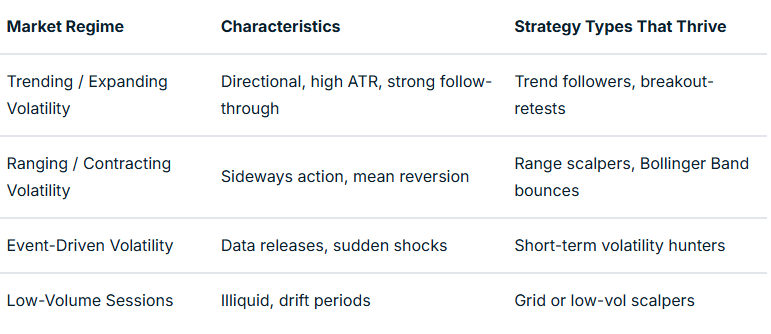
Multi-Level Analysis: From Composition to Interaction
Once your book is structured, the challenge is to turn it into something workable. An additional layer of refinement that turns theory and measurement into something meaningful in action is where any difference will be made.
This “closing the circle” is based on evidence and a true understanding of how your EAs are behaving together. It is the step that takes you to the point where automation can begin to move to the next level.
Mapping relationships with robust and detailed performance evaluation will take time to provide evidence that these are actually making a difference in meeting balancing aims.
To really excel, you should have systems in place that allow ongoing evaluation of the approaches you are using and advise of refinements that may improve things over time.
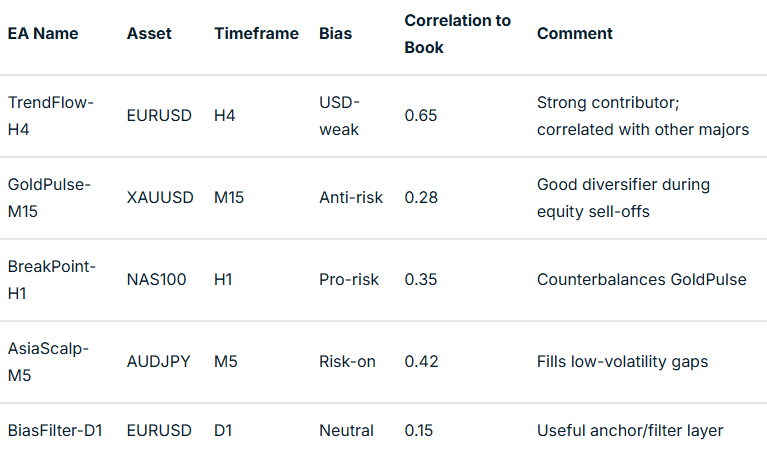
What Next? – Implementing Balance in Practice
Theory must ultimately translate into an executable EA book. A plan of action with landmarks to show progress and maintain motivation is crucial in this approach.
Defining classification tags, setting risk weights, and building monitoring dashboards are all worth consideration.
Advanced EA traders could also consider a supervisory ‘Sentinel’ EA, or ‘mothership’ approach, to enable or disable EAs dynamically based on underlying market metrics and external information integrated into EA coding decision-making.
Final Thoughts
A balanced EA portfolio is not generated by accident; it is well-thought-out, evidence-based and a continuously developing architecture. It is designed to offer improved risk management across your EA portfolio and improved trading outcomes.
Your process begins with mapping your existing strategies by number, asset, and timeframe, then expands into analysing correlations, directional bias, and volatility regimes.
When you reach the stage where one EA’s drawdown is another’s opportunity, you are no longer simply trading models but managing a system of EA systems. To finish, ask yourself the question, “Could this approach contribute to improved outcomes over time?”. If your answer is “yes,” then your mission is clear.
If you are interested in learning more about adding EAs to your trading toolbox, join the new GO EA Programme (coming soon) by contacting [email protected].


Introduction in the constant pursuit of market edge, traders often find themselves crowded into the same analytical spaces, watching identical indicators and acting on similar signals. This collective attention of market participants potentially creates a paradox: the more traders follow conventional signals, the less effective these signals become. While price action, volume, moving averages, and oscillators dominate trading screens worldwide, beneath the visible surface of market activity lies a rich ecosystem of "silent indicators" that often telegraph significant moves long before they materialize in price.
The financial markets do not exist as isolated entities for specific assets but rather as an interconnected web where currencies influence commodities, bonds telegraph equity movements as obvious examples. Understanding these cross-market relationships enables traders to assemble a more complete market picture and recognise the early warning signs that often precede major moves. This is not an exhaustive list but aims to cover some of the key factors that also offer an opportunity of accessibility for the retail trader.
I have suggested some sources that may be useful. This article explores these potentially overlooked signals across multiple asset classes, providing traders with a framework to identify market shifts before they become apparent to the majority. Section 1: Institutional Footprints Volume Profile Analysis Core Concept: Volume profile analysis examines how trading volume distributes across price levels rather than just time periods, revealing where significant transactions occurred and potentially where institutional interest exists.
Point of Control Significance: The price level with the highest trading volume (Point of Control) often acts as a magnet during future trading sessions, as this represents the price where most transactions were agreed upon. Volume Nodes and Gaps: Areas with sparse trading volume often become "vacuum zones" where price can move rapidly when entered, while high-volume nodes frequently act as support/resistance. Retail-Accessible Sources: TradingView Volume Profile indicator (free/premium) Sierra Chart volume profile tools (subscription) Tradovate volume profile tools (subscription) Open Interest Changes in Futures and Options Core Concept: Open interest represents the total number of outstanding contracts in derivatives markets.
Changes in open interest, when combined with price movement, provide insights into whether new money is entering a trend or positions are being closed. Confirmation Signals: Rising prices with rising open interest confirms bullish momentum (new buyers entering); falling prices with rising open interest confirms bearish momentum (new sellers entering). Warning Signals: Rising prices with falling open interest suggests a weakening trend (shorts covering); falling prices with falling open interest suggests a weakening downtrend (longs liquidating).
Options Open Interest Concentration: Unusual accumulation of open interest at specific strike prices often indicates institutional positioning and can create price magnets or barriers. Retail-Accessible Sources: CME Group open interest data (free) TradingView futures open interest indicators (free/premium) Barchart.com options open interest data (free/premium) CBOE options volume and open interest (free) Commitment of Traders Analysis Core Concept: The Commitment of Traders (COT) report breaks down the holdings of different trader categories (commercial, non-commercial, small speculators) in futures markets, revealing how different market participants are positioned. Commercial vs.
Speculator Divergence: When commercial hedgers (smart money) and speculators (often trend-followers) show extreme position differences, it often signals potential market turning points. Historically Significant Extremes: Comparing current positioning to historical extremes provides context—when any group reaches unusual net long or short positions, mean reversion often follows. Multi-Market Applications: COT data covers currencies, commodities, bonds, and equity index futures, allowing for cross-market analysis and early warning of sentiment shifts.
Retail-Accessible Sources: CFTC COT reports (free, weekly) Investing.com COT data visualizations (free) BarcChart.com COT charts (free/premium) TradingView COT indicators (community scripts, free) Section 2: Sentiment Indicators Beyond the Headlines Market Internals Across Asset Classes Core Concept: Market internals measure the underlying strength or weakness of a market beyond just the headline index price. These include advance-decline lines, new highs vs. new lows, and percentage of assets above moving averages. Breadth Divergences: When market indices make new highs while internals weaken (fewer stocks participating in the advance), it often signals deteriorating market health before price confirms.
Confirming Strength: Strong internals during consolidations or minor pullbacks often indicate underlying buying pressure and increase the probability of continuation. Cross-Asset Applications: This concept applies beyond stocks—measuring the percentage of commodities in uptrends, currencies strengthening against the dollar, or global markets above their moving averages provides comprehensive market health metrics. Retail-Accessible Sources: StockCharts.com market breadth indicators (free/subscription) TradingView breadth indicators (free/premium) Investors.com market pulse data (subscription) DecisionPoint breadth charts (StockCharts subscription) Retail vs.
Institutional Sentiment Divergence Core Concept: When retail traders' sentiment significantly diverges from institutional positioning, the smart money view typically prevails. This divergence creates opportunities for contrarian traders. Retail Sentiment Gauges: Social media sentiment, trading app popularity rankings, and retail-focused brokerage positioning data reveal retail trader enthusiasm.
Institutional Positioning Clues: Fund flow data, professional survey results, and positioning metrics from prime brokers indicate institutional sentiment. Warning Signs: Extreme retail enthusiasm combined with institutional caution often precedes corrections; retail pessimism with institutional accumulation frequently precedes rallies. Retail-Accessible Sources: AAII Investor Sentiment Survey (free) TradingView Social Sentiment indicator (free) CNN Fear & Greed Index (free) Volatility Term Structure Core Concept: The volatility term structure shows expected volatility across different time frames.
The relationship between near-term and longer-term volatility expectations provides insights into market stability. Contango vs. Backwardation: Normal markets show higher volatility expectations for longer time frames (contango); inverted term structure (backwardation) signals immediate market stress and often precedes significant moves.
Term Structure Shifts: Sudden changes in the volatility curve often precede major market regime changes, even when the headline volatility index appears stable. Cross-Asset Volatility Comparison: Comparing volatility in related markets (e.g., currency volatility vs. equity volatility) can reveal building stress in one market before it impacts others. Retail-Accessible Sources: CBOE VIX term structure (free) VIX futures curve data on futures exchanges (free) TradingView VIX futures spread indicators (free/premium) LiveVol (CBOE) volatility data (free/subscription) Section 3: Cross-Asset Correlations Currency/Commodity Relationships Core Concept: Specific currency pairs often move in tandem with related commodities due to economic linkages—AUD with iron ore and coal, CAD with oil, NOK with natural gas, etc.
Divergences between the two can signal changing fundamentals. Leading Indicators: Currency moves frequently lead commodity price movements due to currency markets' greater liquidity and sensitivity to changing economic conditions and capital flows. Correlation Breakdowns: When previously correlated assets decouple, it often signals a fundamental shift in market dynamics or the emergence of a new driving factor.
Practical Trading Applications: Monitoring currency moves can provide early warning for commodity traders; likewise, significant commodity price changes may predict currency movements before they occur. Retail-Accessible Sources: TradingView correlation indicator (free/premium) Investing.com currency and commodity charts (free) MacroMicro correlation tables (free/subscription) FXStreet correlation tables (free) Real-World Example: A clear illustration occurred in February 2025 when the Australian dollar (AUD) began weakening against major currencies despite stable iron ore prices. Traditionally, these two assets move in tandem due to Australia's position as a major iron ore exporter.
Traders monitoring this relationship noticed the divergence—the currency was signalling weakness while the commodity remained strong. Within three weeks, iron ore prices began a significant decline that the currency had "predicted" through its earlier weakness. Commodity traders who observed this currency leading indicator had already reduced exposure before the commodity price drop materialized.
Bond Market Leading Indicators Core Concept: Fixed income markets often signal economic changes before they appear in other asset classes. Key relationships like yield curve steepness, credit spreads, and bond market volatility frequently lead equity, commodity, and currency moves. Yield Curve Analysis: The relationship between short-term and long-term interest rates reflects economic expectations—flattening/inverting curves often precede economic slowdowns, while steepening curves frequently signal growth and inflation.
Credit Spread Warnings: Widening spreads between government bonds and corporate debt indicate increasing risk aversion; sector-specific spread widening often precedes industry-specific equity weakness. Treasury-Inflation Protected Securities (TIPS): The break-even inflation rate derived from conventional Treasuries and TIPS reveals market inflation expectations, often leading commodity price trends. Retail-Accessible Sources: FRED (Federal Reserve Economic Data) yield curve data (free) Bond charts and indicators (most CFD trading platforms) Investing.com bond market data (free) Koyfin yield curve visualization (free/subscription) Real-World Example: In mid-2024, while most equity markets were still rallying, high-yield corporate bond spreads began widening subtly against Treasury bonds.
This credit spread expansion wasn't making headlines, but traders monitoring these relationships noted the growing risk aversion in fixed income markets. Within six weeks, this "silent indicator" from the bond market manifested in equity markets as increased volatility and sector rotation away from higher-risk growth stocks. Traders who recognized this early warning sign had already adjusted their equity exposure and positioned defensively before the shift became obvious in stock prices.
Dollar Index Correlations Core Concept: The U.S. Dollar Index (DXY) has strong inverse relationships with many asset classes. Understanding dollar strength or weakness provides context for moves in commodities, emerging markets, and multinational companies.
Commodity Price Impacts: Most commodities are priced in dollars, creating an inherent inverse relationship—dollar strength typically pressures commodity prices, while dollar weakness often supports them. Global Risk Sentiment Indicator: In risk-off environments, the dollar frequently strengthens as capital seeks safety; in risk-on periods, it often weakens as capital flows to higher-yielding assets. Correlation Phases: The dollar's correlation with other assets isn't static—it shifts based on market regimes and dominant narratives.
Identifying the current correlation regime is essential for proper interpretation. Retail-Accessible Sources: TradingView dollar index charts (free/premium) Finviz.com correlation matrix (free) Investing.com currency correlation tables (free) MarketWatch dollar index data (free) Section 4: Time-Based Indicators Trading Session Patterns and Handoffs Core Concept: Global markets operate in a continuous cycle as trading activity moves from Asia to Europe to North America. How markets behave during these handoffs and how one region responds to another's moves provides valuable context.
Overnight Price Action Significance: Gaps between sessions often reveal institutional positioning; consistent patterns of overnight strength or weakness can identify the dominant trading region driving a trend. Regional Divergences: When markets in different regions begin showing different directional biases (e.g., Asian markets weak while European markets strengthen), it often signals changing global capital flows and potential trend shifts. Volume Distribution Changes: Shifts in when the bulk of trading volume occurs during 24-hour markets (FX, futures) often indicate changing participant behaviour and potential trend exhaustion.
Retail-Accessible Sources: Investing.com global indices charts (free) FXStreet session times indicator (free) Electronic market hours gap analysis on any charting platform Market Range Development Core Concept: Markets typically establish daily, weekly, and monthly trading ranges. How price behaves within these ranges, how it tests boundaries, and how ranges evolve over time reveals underlying market dynamics. Opening Range Theory: The initial trading range established in the first 30-60 minutes often defines the day's battleground; breakouts or failures from this range frequently determine session direction.
Weekly Range Analysis: Weekly opening gaps and the market's response to the previous week's high/low levels provide context for likely price behaviour; persistent testing of the same levels indicates important price zones. Range Expansion/Contraction Cycles: Markets cycle between periods of range expansion (trending) and range contraction (consolidation); identifying these patterns helps anticipate transitions between trading strategies. Retail-Accessible Sources: TradingView range tools and indicators (free/premium) Trading session opening range indicators (available on most platforms) Average True Range (ATR) studies (available on all platforms) Session high/low markers (available on most platforms) Seasonal and Calendar Effects Core Concept: Despite market evolution, certain calendar-based patterns maintain statistical significance when viewed over long timeframes.
These patterns create probabilistic edges for specific time periods when combined with confirming indicators. Monthly Patterns: Many markets show persistent strength or weakness in certain months due to fiscal year timing, commodity production cycles, and institutional fund flows. Day-of-Week Tendencies: Statistical analysis reveals certain days consistently show different characteristics—some favor trend continuation while others show mean reversion tendencies.
Market-Specific Cycles: Each market has unique seasonal patterns—agricultural commodities follow growing seasons, energy markets follow consumption patterns, currencies reflect trade flow timing, etc. Retail-Accessible Sources: TradingView seasonality indicators (community scripts, free) Equity Clock seasonal charts (free) Moore Research seasonal patterns (free/subscription) Seasonal Charts website (free) Time-Based Divergences Core Concept: Comparing market behaviour across different timeframes reveals momentum shifts before they become obvious. When shorter timeframes begin showing different behaviour than longer timeframes, it often signals changing sentiment.
Multiple Timeframe Analysis: Systematically comparing price action, momentum, and volume across different time periods (daily/weekly/monthly or hourly/4-hour/daily) provides context and early warning of trend changes. Period-to-Period Momentum: Tracking how momentum builds or fades across consecutive time periods reveals the strength or weakness of underlying trends before price confirms. Cycle Analysis: Markets move in overlapping cycles of different durations; identifying when multiple cycles align in the same direction or conflict provides insight into potential market turning points.
Retail-Accessible Sources: TradingView multi-timeframe indicators (free/premium) Multiple timeframe RSI divergence tools (available on most platforms) Multi-timeframe comparison templates (available in most trading platforms) Section 5: Integration Framework Building a Cross-Asset Dashboard Core Concept: Creating a systematic approach to monitoring multiple signals across different markets prevents information overload and reveals interconnections between seemingly unrelated indicators. Core Components: An effective dashboard should include: 1) Market regime indicators, 2) Cross-asset correlation monitors, 3) Sentiment gauges, 4) Leading indicators for each asset class, and 5) Anomaly alerts. Visual Organization: Arranging indicators by function rather than by asset class helps identify relationships—group all breadth measures together, all momentum indicators together, etc., across different markets.
Alert Parameters: Establish threshold levels for each indicator based on historical analysis, creating a system that flags only statistically significant deviations rather than normal market noise. Retail-Accessible Sources: MetaEditor development of custom indicators (free/premium but requires programming skills – although these can be accessed) Excel/Google Sheets dashboards with imported data MultiCharts custom workspaces (subscription) Signal Weighting and Contextual Analysis Core Concept: Not all indicators work equally well in all market environments. Adapting signal importance based on prevailing conditions—trending vs. ranging, high vs. low volatility, risk-on vs. risk-off—improves accuracy.
Market Regime Classification: Develop a systematic method to identify the current market regime using volatility metrics, correlation patterns, and trend strength measures. Conditional Signal Weighting: Assign different importance to indicators based on the current regime—momentum signals matter more in trending markets, while overbought/oversold indicators work better in ranging markets. Confidence Scoring System: Create a weighted scoring system that combines multiple indicators, giving greater weight to those with proven effectiveness in the current market environment.
Retail-Accessible Sources: Excel/Google Sheets for scoring models Trading journal software or “script” code development to track signal effectiveness Time Horizon Alignment Core Concept: Different indicators provide signals for different time horizons. Aligning indicator selection with your trading timeframe prevents conflicting signals and improves decision-making clarity. Signal Categorization: Classify each indicator by its typical lead time—some provide immediate tactical signals, others medium-term directional bias, and others long-term strategic positioning information.
Timeframe Congruence: Look for situations where signals align across multiple timeframes, creating higher-probability trade opportunities with defined short and long-term objectives. Conflicting Signal Resolution: Develop a framework for resolving conflicting signals between timeframes—typically by giving priority to the timeframe that matches your trading horizon. Retail-Accessible Sources: Trading journal to track signal effectiveness by timeframe Strategy backtesting tools to verify signal efficacy for specific timeframes Develop Custom multi-timeframe indicators (e,g, in MetaEditor) Conclusion and Your Potential Next Steps The key message throughout this article is that markets communicate through multiple channels simultaneously.
No single indicator provides a complete picture, but when disparate signals begin to align across different asset classes and timeframes, they create a compelling narrative about possible market direction. The trader who recognizes these patterns may gain the ability to position ahead of the crowd rather than simply reacting to price movements after they've occurred. As a suggestion, begin by selecting just two or three indicators from different categories that complement your existing strategy and time availability.
For example, a stock trader might add bond market signals and currency relationships to provide context for equity positions. A commodity trader could benefit from monitoring related currency pairs and institutional positioning through COT reports. Above all, remember that these indicators exist within a complex market ecosystem.
Interpreting them requires context—understanding the prevailing market regime, volatility environment, and broader narrative driving asset prices. An edge in trading has always belonged to those who can interpret what the market is saying before it becomes obvious to everyone else. By listening to the market's quieter signals, you position yourself to hear tomorrow's news today.

